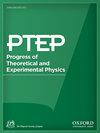利用月球观测数据对 GroundBIRD 望远镜进行指向校准
IF 8.3
4区 物理与天体物理
Q1 Physics and Astronomy
引用次数: 0
摘要
了解望远镜的指向(即视线)对于观测宇宙微波背景(CMB)和天体非常重要。月球是进行指向校准的一个候选天文源。虽然月球的可见光尺寸(30')比行星大,但我们每月可以频繁观测月球一次,而且信噪比很高。我们开发了一种利用月球观测数据进行指向校准的方法。在进行指向校准时,我们考虑了望远镜轴的倾斜以及编码器和准直偏移。此外,我们还评估了月球亮度温度不均匀性的影响,这是一个主要的系统误差。结果,我们成功实现了 3.3 英尺的指向精度。这比 36 英尺的角度分辨率要小一个数量级。这一精度水平可与过去其他使用行星观测数据的地面 CMB 实验的成果相媲美。本文章由计算机程序翻译,如有差异,请以英文原文为准。
Pointing calibration of GroundBIRD telescope using Moon observation data
Understanding telescope pointing (i.e., line of sight) is important for observing the cosmic microwave background (CMB) and astronomical objects. The Moon is a candidate astronomical source for pointing calibration. Although the visible size of the Moon (30’) is larger than that of the planets, we can frequently observe the Moon once a month with a high signal-to-noise ratio. We developed a method for performing pointing calibration using observational data from the Moon. We considered the tilts of the telescope axes as well as the encoder and collimation offsets for pointing calibration. In addition, we evaluated the effects of the nonuniformity of the brightness temperature of the Moon, which is a dominant systematic error. As a result, we successfully achieved a pointing accuracy of 3.3’. This is one order of magnitude smaller than an angular resolution of 36’. This level of accuracy competes with past achievements in other ground-based CMB experiments using observational data from the planets.
求助全文
通过发布文献求助,成功后即可免费获取论文全文。
去求助
来源期刊

Progress of Theoretical and Experimental Physics
PHYSICS, MULTIDISCIPLINARY-PHYSICS, PARTICLES & FIELDS
CiteScore
12.00
自引率
5.70%
发文量
148
审稿时长
17 weeks
期刊介绍:
Progress of Theoretical and Experimental Physics (PTEP) is an international journal that publishes articles on theoretical and experimental physics. PTEP is a fully open access, online-only journal published by the Physical Society of Japan.
PTEP is the successor to Progress of Theoretical Physics (PTP), which terminated in December 2012 and merged into PTEP in January 2013.
PTP was founded in 1946 by Hideki Yukawa, the first Japanese Nobel Laureate. PTEP, the successor journal to PTP, has a broader scope than that of PTP covering both theoretical and experimental physics.
PTEP mainly covers areas including particles and fields, nuclear physics, astrophysics and cosmology, beam physics and instrumentation, and general and mathematical physics.
 求助内容:
求助内容: 应助结果提醒方式:
应助结果提醒方式:


